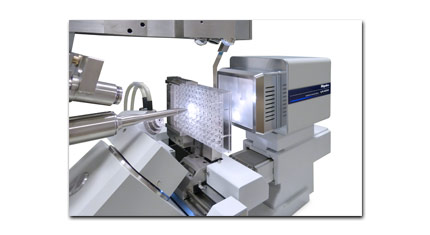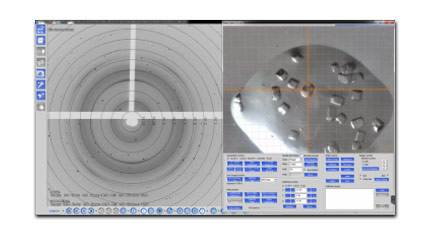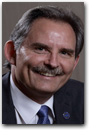|
Crystallography in the News
May 1, 2018. Joshua Riback, a University of Chicago graduate student in Biophysical Sciences, has received the 2018 Rosalind Franklin Investigator Award from the Advanced Photon Source (APS) Users Organization at the U.S. Department of Energy's (DOE) Argonne National Laboratory.
May 3, 2018. Researchers are commercializing a new method for determining the crystal structures of organic salts – which make up 40% of all advanced pharmaceutical ingredients – which could "greatly speed up" the drug development process.
May 7, 2018. Pore-forming toxins are bacterial poisons that destroy cells by creating holes in the cell membranes. Combining crystallographic and cryo-electron microscopy methods, Bastian Bräuning and Professor Michael Groll from the Department of Biochemistry, in collaboration with Eva Bertosin and Professor Hendrik Dietz from the Department of Experimental Biophysics, managed to shed light upon the precise molecular structures of the soluble individual components, as well as the pore complex.
May 10, 2018. Biopharmaceutical company NeuClone has announced positive preclinical results of its biosimilar to Johnson & Johnson's Stelara®, including 3-dimensional (3-D) structure confirmation through X-ray crystallography analysis. A biosimilar is a biopharmaceutical drug designed to have active properties similar to one that has previously been licensed.
May 14, 2018. A crystallographer's view of prime numbers: theoretical chemist Salvatore Torquato met with the number theorist Matthew de Courcy-Ireland to explain that he had done something highly unorthodox: he performed diffraction on sequences of prime numbers.
May 14, 2018. The aim of the "scoring project" at Gakushuin University was to update the next generation about the plasticity of protein structures in a comprehensive and reproducible manner on one hand and to accumulate basic data for exploring the nature of life in the other.
May 19, 2018. Researchers at the University of Washington School of Medicine used X-ray crystallography to determine the structure of the normal and mutated versions of the transmembrane voltage sensor in cell membranes at atomic resolution. They found that mutations responsible for hypokalemic periodic paralysis create a small hole through the center of the voltage sensor in the sodium channel protein.
May 21, 2018. Over the past decade, fragment-based drug discovery (FBDD) has garnered increasing interest among drug discovery experts and has established itself as a key approach within the field – acting as an alternative starting point for the discovery of high-quality lead candidates.
Product Spotlight

XtalCheck
The XtalCheck system is an automated tool for performing in situ crystallography experiments on your existing X-ray diffraction system. Protein crystallography often requires screening large numbers of crystals to identify samples that are suitable for X-ray diffraction experiments. Specifically, crystallographers usually loop and cryo-freeze samples for X-ray screening to identify whether the sample contains a protein or salt and to evaluate diffraction resolution, mosaicity and other crystal parameters. This iterative process of mounting and screening of many samples is time consuming and rarely automated. The XtalCheck system addresses this bottleneck by automating diffraction data collection for crystals directly from SBS format crystallization plates.
The XtalCheck system includes software that facilitates both visual and diffraction imaging of crystallization experiments. With the XtalCheck system, one can easily survey many crystallization experiments by eliminating the need to harvest and cryo-cool samples. Moreover, one can perform serial crystallography experiments, by collecting data from multiple crystals, to achieve complete data sets that can be used for structure solution.

Features
- Quickly survey crystals prior to cryo-freezing
- Simple queuing of crystal objects for diffraction screening
- Data collection for sample queue progresses without user intervention
- Assign multiple crystal objects per drop
For more information on the XtalCheck >
Lab in the Spotlight
 Professor Jay S. Siegel
Professor Jay S. Siegel
School of Pharmaceutical Science and Technology
Room A203, Building 24, Tianjin University
Professor Siegel's research combines synthetic and physical organic chemistry with an eye toward issues of pharmaceutical, material, and life science. The group uses the three principle components of modern stereochemistry: molecular design, chemical synthesis, and structural analysis to accomplish its goals. Robust transmission of structural and stereo-chemical information is fundamental to selective chemical processes such as (bio)molecular recognition, enantioselective reactions, and the assembly of designed materials. Beyond symmetry and molecular bonding, stereochemical investigations draw upon concepts from many disciplines and implement techniques such as synthetic methodology, X-ray crystallography, NMR spectroscopy, and computational theory.
Useful Links
AIP publishes an informative weekly newsletter titled FYI: Science Policy News from AIP. You can subscribe to it at www.aip.org/fyi/fyi_subscribe. You will also receive bulletins about science-related policy issues as they happen.
There will be lots of neat stuff in the night sky this summer as described here. On May 11, just three days after Jupiter's closest approach this year, I pulled out the telescope and kids from 5 to 95 saw Jupiter and the 4 Galilean moons for the first time. What fun. In June we'll do the same for Saturn, which will be on its side so the rings will be fully visible. www.cfa.harvard.edu/skyreport is a useful website to guide you in showing the wonders of the night to your neighbors.
I noticed something different a couple of Saturdays ago at the New York Times web site – This Week in Good News – and found it a refreshing break from the daily grind. Since everyone is allowed 20 free reads a month, anyone can enjoy the weekly articles in their entirety.
Selected Recent Crystallographic Papers
X-ray Crystallography Analysis of Complexes Synthesized with Tris(2-pyridylmethyl)amine: A Laboratory Experiment for Undergraduate Students Integrating Interdisciplinary Concepts and Techniques. Bazley, Isabel J.; Erie, Ellen A.; Feiereisel, Garrett M.; LeWarne, Christopher J.; Peterson, Jack M.; Sandquist, Katherine L.; Oshin, Kayode D.; Zeller, Matthias. Journal of Chemical Education. 5/8/2018, Vol. 95 Issue 5, p876-881. 6p. DOI: 10.1021/acs.jchemed.7b00685.
Syntheses of PDE3A inhibitor ORG9935 and determination of the absolute stereochemistries of its enantiomers by X-ray crystallography. Jakkaraj, Sudhakar R.; Jr.Young, Victor G.; Georg, Gunda I. Tetrahedron. May2018, Vol. 74 Issue 22, p2769-2774. 6p. DOI: 10.1016/j.tet.2018.04.045.
Evaluating Iodine Uptake in a Crystalline Sponge Using Dynamic X-ray Crystallography. Gee, William J.; Hatcher, Lauren E.; Cameron, Christopher A.; Stubbs, Clare; Warren, Mark R.; Burrows, Andrew D.; Raithby, Paul R. Inorganic Chemistry. 5/7/2018, Vol. 57 Issue 9, p4959-4965. 7p. DOI: 10.1021/acs.inorgchem.7b03218.
Deuteration of human carbonic anhydrase for neutron crystallography: Cell culture media, protein thermostability, and crystallization behavior. Koruza, K.; Lafumat, B.; Végvári, Á.; Knecht, W.; Fisher, S.Z. Archives of Biochemistry & Biophysics. May2018, Vol. 645, p26-33. 8p. DOI: 10.1016/j.abb.2018.03.008.
MX2: a high-flux undulator microfocus beamline serving both the chemical and macromolecular crystallography communities at the Australian Synchrotron. Aragão, David; Aishima, Jun; Cherukuvada, Hima; Clarken, Robert; Clift, Mark; Cowieson, Nathan Philip; Ericsson, Daniel Jesper; Gee, Christine L.; Macedo, Sofia; Mudie, Nathan; Panjikar, Santosh; Price, Jason Roy; Riboldi-Tunnicliffe, Alan; Rostan, Robert; Williamson, Rachel; Caradoc-Davies, Thomas Tudor. Journal of Synchrotron Radiation. May2018, Vol. 25 Issue 3, p885-891. 6p. DOI: 10.1107/S1600577518003120.
A convolutional neural network-based screening tool for X-ray serial crystallography. Ke, Tsung-Wei; Brewster, Aaron S.; Yu, Stella X.; Ushizima, Daniela; Yang, Chao; Sauter, Nicholas K. Journal of Synchrotron Radiation. May2018, Vol. 25 Issue 3, p655-670. 15p. DOI: 10.1107/S1600577518004873.
Structure of aqueous cesium metaborate solutions by X-ray scattering and DFT calculation. Zhang, W.Q.; Fang, C.H.; Fang, Y.; Zhu, F.Y.; Zhou, Y.Q.; Liu, H.Y.; Li, W. Journal of Molecular Structure. May2018, Vol. 1160, p26-32. 7p. DOI: 10.1016/j.molstruc.2017.12.099.
Electric-Field-Assisted Protein Crystallization in Continuous Flow. Fei Li; Lakerveld, Richard. Crystal Growth & Design. 5/2/2018, Vol. 18 Issue 5, p2964-2971. 8p. DOI: 10.1021/acs.cgd.8b00095.
An efficient screening method for purifying and crystallizing membrane proteins using modified clear-native PAGE. Suzuki, Nanao; Takamuku, Yuuki; Murata, Takeshi; Asakawa, Tomohiro; Inai, Makoto; Kan, Toshiyuki; Hino, Tomoya; Iwata, So. Analytical Biochemistry. May2018, Vol. 548, p7-14. 8p. DOI: 10.1016/j.ab.2018.02.007.
A Mechanism of Calmodulin Modulation of the Human Cardiac Sodium Channel. Johnson, Christopher N.; Potet, Franck; Thompson, Matthew K.; Kroncke, Brett M.; Glazer, Andrew M.; Voehler, Markus W.; Knollmann, Bjorn C.; Jr.George, Alfred L.; Chazin, Walter J. Structure. May2018, Vol. 26 Issue 5, p683-694.e3. 1p. DOI: 10.1016/j.str.2018.03.005.
Crystal structure of the Melampsora lini effector AvrP reveals insights into a possible nuclear function and recognition by the flax disease resistance protein P. Zhang, Xiaoxiao; Farah, Nadya; Rolston, Laura; Ericsson, Daniel J.; Catanzariti, Ann-Maree; Bernoux, Maud; Ve, Thomas; Bendak, Katerina; Chen, Chunhong; Mackay, Joel P.; Lawrence, Gregory J.; Hardham, Adrienne; Ellis, Jeffrey G.; Williams, Simon J.; Dodds, Peter N.; Jones, David A.; Kobe, Bostjan. Molecular Plant Pathology. May2018, Vol. 19 Issue 5, p1196-1209. 14p. DOI: 10.1111/mpp.12597.
Crystal structures of human CK2α2 in new crystal forms arising from a subtle difference in salt concentration. Tsuyuguchi, Masato; Nakaniwa, Tetsuko; Kinoshita, Takayoshi. Acta Crystallographica: Section F, Structural Biology Communications. May2018, Vol. 74 Issue 5, p288-293. 5p. DOI: 10.1107/S2053230X18005204.
Structural insights into serotonin receptor ligands polypharmacology. Podlewska, Sabina; Kafel, Rafal; Lacivita, Enza; Satala, Grzegorz; Kooistra, Albert J.; Vass, Márton; De Graaf, Chris; Leopoldo, Marcello; Bojarski, Andrzej J.; Mordalski, Stefan. European Journal of Medicinal Chemistry. May2018, Vol. 151, p797-814. 18p. DOI: 10.1016/j.ejmech.2018.04.010.
Utilizing a structure-based docking approach to develop potent G protein-coupled receptor kinase (GRK) 2 and 5 inhibitors. Waldschmidt, Helen V.; Bouley, Renee; Kirchhoff, Paul D.; Lee, Pil; Tesmer, John J.G.; Larsen, Scott D. Bioorganic & Medicinal Chemistry Letters. May2018, Vol. 28 Issue 9, p1507-1515. 9p. DOI: 10.1016/j.bmcl.2018.03.082.
Crystal Structure of Ripk4 Reveals Dimerization-Dependent Kinase Activity. Huang, Christine S.; Oberbeck, Nina; Hsiao, Yi-Chun; Liu, Peter; Johnson, Adam R.; Dixit, Vishva M.; Hymowitz, Sarah G. Structure. May2018, Vol. 26 Issue 5, p767-777.e5. 1p. DOI: 10.1016/j.str.2018.04.002.
Biochemical characterization, low-resolution SAXS structure and an enzymatic cleavage pattern of BlCel48 from Bacillus licheniformis. de Araújo, Evandro Ares; Manzine, Lívia Regina; Piiadov, Vassili; Kadowaki, Marco Antonio Seiki; Polikarpov, Igor. International Journal of Biological Macromolecules. May2018, Vol. 111, p302-310. 9p. DOI: 10.1016/j.ijbiomac.2017.12.138.
Book Review
 Leonardo da Vinci by Walter Isaacson, ISBN-13: 978-1501139154.
Leonardo da Vinci by Walter Isaacson, ISBN-13: 978-1501139154.
Walter Isaacson's latest biography is an intimate venture into the life of Leonardo da Vinci: artist, sculptor, engineer, inventor, and even, one might argue, amateur coroner.
Isaacson includes some helpful guides for the reader at the beginning of the book. This includes, but is not limited to: a cast of characters with brief biographies; information about Italian currency circa 1500 and how it compares to the modern-day U.S. dollar; and, most importantly, a detailed timeline of Leonardo's life and work (complete with color images) juxtaposed with a timeline of important events around the world for context.
Leonardo, thanks to his painted masterpieces, namely The Last Supper and Mona Lisa, is first and foremost remembered as an artist. And Isaacson's da Vinci feels like an art history textbook, complete with thick, glossy pages and high-resolution color images of Leonardo's work (painted, sketched, and otherwise).
But despite textbook appearances, Isaacson's book is a true biography of the man—and an interesting, compelling one at that. Even if you think you know everything there is to know about da Vinci, you will definitely learn at least one new thing, if not more.
Isaacson starts with Leonardo's childhood in the small Italian town of Vinci, outside Florence. As an illegitimate child, Leonardo split his childhood between his mother's home and his father's parents. His illegitimacy was a blessing in disguise: it meant he could pursue his passions as a young man instead of following in his father's footsteps as a notary. It also meant Leonardo was never formally educated. Even in his old age, he considered himself a man of experience rather than a man of books.
When Leonardo was 12, he moved to Florence with his father. The city, then under the control of the Medici family, was a cultural center—a nexus for artists, architects, and sculptors. By the time Leonardo was 14, his father had arranged an apprenticeship for him in the workshop of a master artist: Andrea del Verrocchio. Some scholars even suspect that Leonardo was the model for Verrochio's David (as in David and Goliath). Under Verrocchio's tutelage, Leonardo developed two techniques that he would continue to use for the rest of his career: chiaroscuro and sfumato. Da Vinci also contributed to several of Verocchio's painted works, such as Tobias and the Angel and Baptism of the Christ.
By the time Leonardo was twenty-four, he had moved out of Verrocchio's workshop and started his own. During this time, he only had three commissioned works—he never started one of them and left the other two unfinished—one of which was Adoration of the Magi.
Following his essential failure in Florence, at age thirty, da Vinci packed up and moved to Milan—he would stay there for seventeen years. In Milan, da Vinci was something of a cultural envoy. He worked on a tremendous number of inventions, such as the crossbow; acted as a court entertainer; and even perfected The Vitruvian Man.
Though not often remembered or regarded as a sculptor (unlike his slightly younger contemporary Michelangelo), Leonardo actually spent five of his years in Milan on a massive horse sculpture for the Duke. The horse was never completed though, due to a series of unfortunate events that culminated in French invaders essentially melting his massive clay model down with flaming arrows.*
Despite the horse setback, da Vinci persevered. He conducted numerous experiments of scientific inquiry, seeking to understand why the sky is blue and how birds fly (spoiler alert: he figured both of these things out hundreds of years before modern particle physics or mechanical engineering). He drew incredible polyhedral figures for his friend Luca Pacioli's book On Divine Proportion. The skillful shading makes the illustrations seeming to leap off the page—they seem truly three-dimensional. He completed a series of commissioned portraits, such as Lady with an Ermine. And then he worked on one of his most famous pieces: The Last Supper.
The death of Leonardo's mother brought him back to Florence, where he worked on numerous projects, including a failed attempt to redirect the Arno river. He also developed a rivalry with Michelangelo. Da Vinci eventually returned to Milan, where he continued his work dissecting corpses and studying human anatomy. He then spent some time in Rome before leaving the country for France, where he was widely revered as a master artist. It was there that he eventually died.
Isaacson ends the book with Mona Lisa, choosing to discuss the work out of chronological order. His point seems to be that the weight of this particular piece would overwhelm any discussion of any other work either before or after it.
One of the interesting segues in the book concerns modern efforts to authenticate works of Renaissance art that some seek to attribute to Leonardo. In da Vinci's time, artists often did not sign their work. Collectors have often sought a windfall from recognizing a work as da Vinci's that was not previously recognized as such—and naturally, chaos ensues. These anecdotes remind us that there is still quite a bit about Leonardo we cannot possibly know—the man lived 500 years ago after all. But it's quite thrilling to think maybe, just maybe, there is an unsigned masterpiece out there, hiding in plain sight, waiting for the right person to stumble upon it.
*Jean Fritz wrote a beautifully illustrated children's book, Leonardo's Horse, about the unfinished statue, and how an American airline pilot worked to help "finish" the piece. You can now see "Leonardo's Horse" in Milan.
Review by Jeanette S. Ferrara, MA
|

